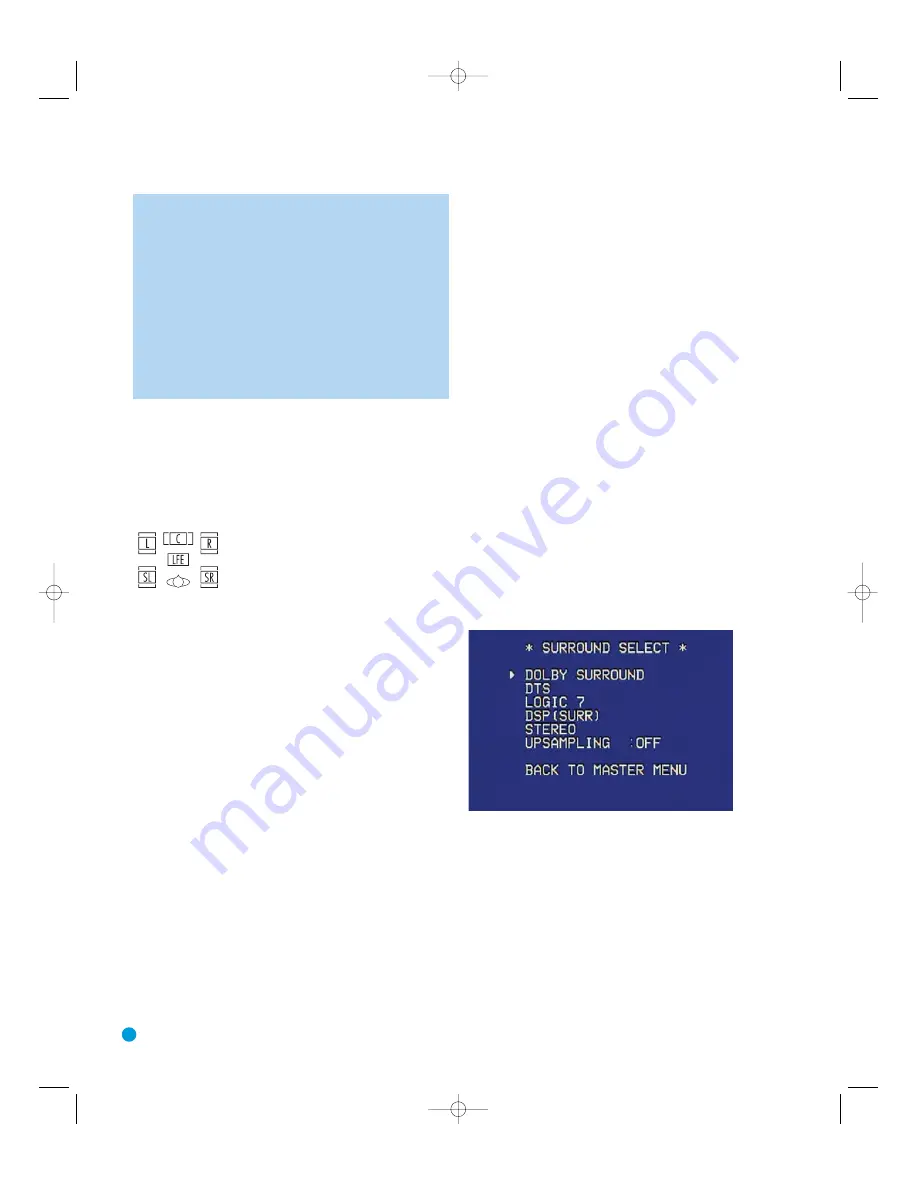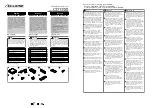
38
ADVANCED FUNCTIONS
NOTE:
The 6.1-channel signals – Dolby Digital EX and DTS-ES
Matrix and Discrete – each include a flag meant to signal the
receiver to decode the surround back channel. For Dolby Digital EX
materials, the incoming bitstream will be displayed as 3/2/.1
EX-ON. For older discs, the display may show EX-OFF. In either
case, since the AVR 144 is not capable of 6.1-channel playback,
the AVR will play the materials in Dolby Digital 5.1 mode.
For DTS-ES materials, the incoming bitstream will be displayed
as 3/3/.1 ES-ON. Again, the materials will only be played in
DTS 5.1 or DTS Neo:6 5-channel mode.
Please refer to Table 4 for more information on which surround
modes are available with different bitstreams.
When a PCM signal is received, the PCM message, followed by the
sampling rate of the signal (44.1kHz, 48kHz or 96kHz), will scroll once
across the front-panel display.
In addition, the Speaker/Channel Input Indicators will indicate the number
of channels discretely encoded in the signal by displaying a letter inside
that channel’s speaker box. See Figure 59. The letters flash when no
signal is present, such as when a DVD is paused.
Figure 59 – Speaker/Channel Input Indicators
Even when only two channels – left and right – are present in the sig-
nal, the analog surround modes may be used to decode the signal into
the remaining channels.
Surround Modes
As mentioned in the Introduction to Home Theater section, surround
mode selection is dependent upon the format of the incoming audio
signal, as well as personal taste. There is no harm in experimenting with
all of the modes available with any given source material. Table 4 offers
a brief description of each mode the AVR 144 is capable of using, and
also indicates the types of incoming signals or digital bitstreams the
mode may be used with. Additional information about Dolby and DTS
modes is available on the companies’ Web sites: www.dolby.com and
www.dtsonline.com.
When in doubt, check the jacket of your DVD for more information on
which surround modes are available on the disc. Be aware that usually
nonessential sections of the disc, such as trailers, extra materials or the
disc menu, are only available in Dolby Digital 2.0 (2-channel) or PCM
2-channel mode. If the main title is playing and the letters in the
Speaker/Channel Input Indicators are not lit for all speaker locations,
look for an audio setup section of the disc’s menu. Also, make sure your
DVD player’s audio output is set to the original bitstream rather than just
PCM. Check the DVD player’s output setting by stopping play of the disc
and checking the DVD player’s menu system.
As indicated in Table 4, different surround modes may only be available
with certain input signals or bitstream formats. For any incoming signal,
only a limited number of surround modes are available. Although there is
never a time when all of the AVR 144’s surround modes are available,
there is usually a wide variety of modes available for a given input.
There are three methods of manually selecting one of the available sur-
round modes:
1. From the front panel, press the Surround Mode Button until the
desired mode group (Dolby, DTS, DSP, Stereo, Logic 7) is selected,
and the last-used mode from that group will be activated. Then press
the Surround Select Button repeatedly to scroll through the modes
available within that group. See Figure 57.
2. Using the remote, press the button for the desired mode group
(see Figure 58):
Dolby Surr for Dolby modes
DTS Sur for DTS Digital modes
DTS Neo:6 for the DTS Neo:6 modes
Logic 7 for the Logic 7 modes
Stereo for the Stereo or Surround Off modes
Surr for the DSP Surround modes (Hall 1, Hall 2, Theater)
Press the mode button repeatedly to scroll through the modes
available within that group.
3. The full-OSD menu system allows access to submenus for each of
the mode groups through the Surround Select menu. See Figure 60.
Figure 60 – Surround Select Menu Screen
Navigate to the line for the desired surround mode group, and press
the Set Button to access the submenu for that group. In most cases,
the submenu consists of only two lines:
1. A MODE line, which displays the currently selected mode. Use the
‹
/
›
Buttons to scroll through the available modes.
2. A BACK TO SURROUND SELECT line, which may be used to exit the
submenu.
The Dolby Surround submenu adds some advanced settings.
HKP1482AVR144-om 9/7/06 3:12 PM Page 38
Содержание AVR 144
Страница 4: ...4 HKP1482AVR144 om 9 7 06 3 10 PM Page 4...
Страница 9: ...9...
Страница 62: ...62 NOTES HKP1482AVR144 om 9 7 06 3 13 PM Page 62...
Страница 63: ...NOTES HKP1482AVR144 om 9 7 06 3 13 PM Page 63...
















































